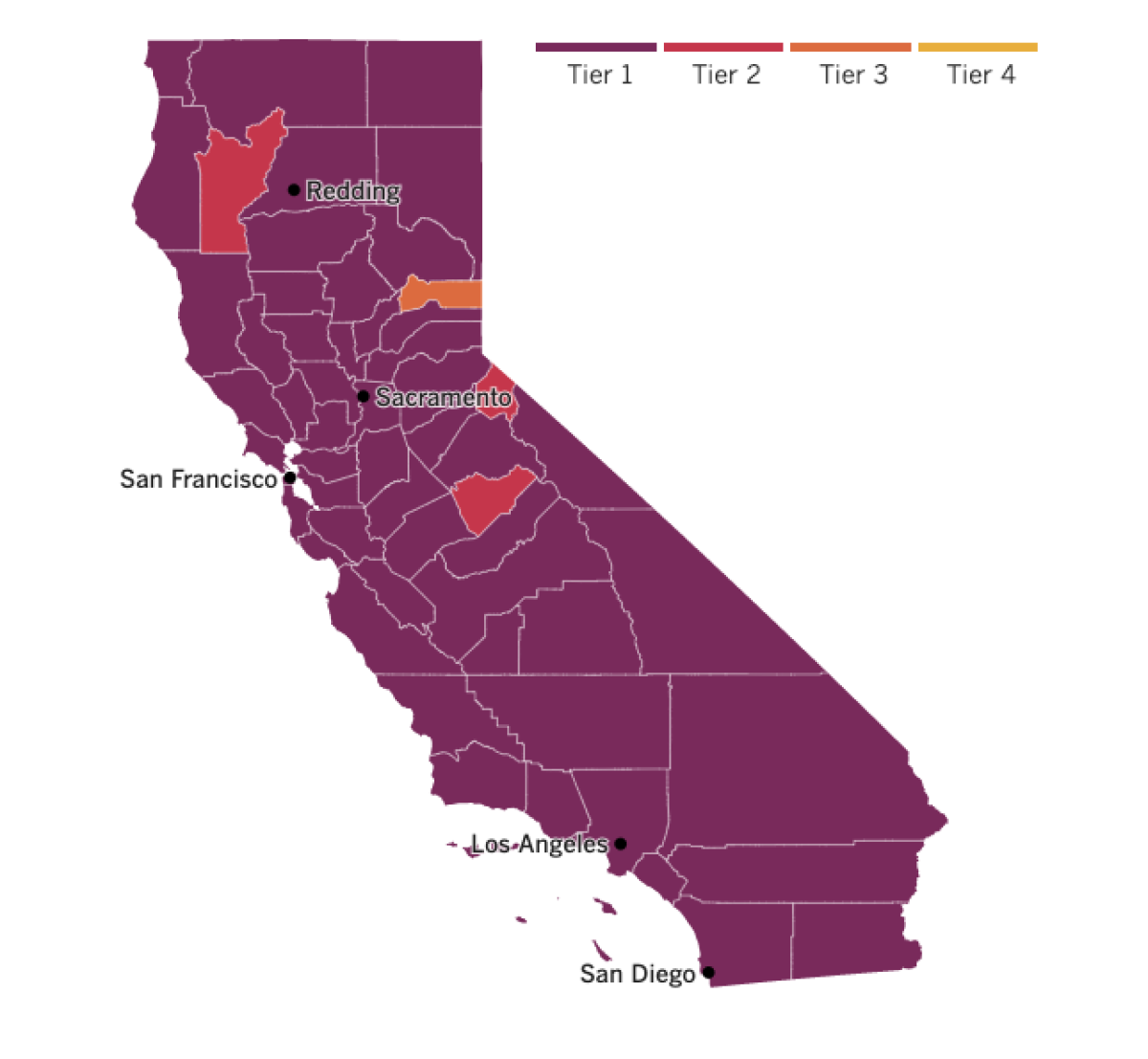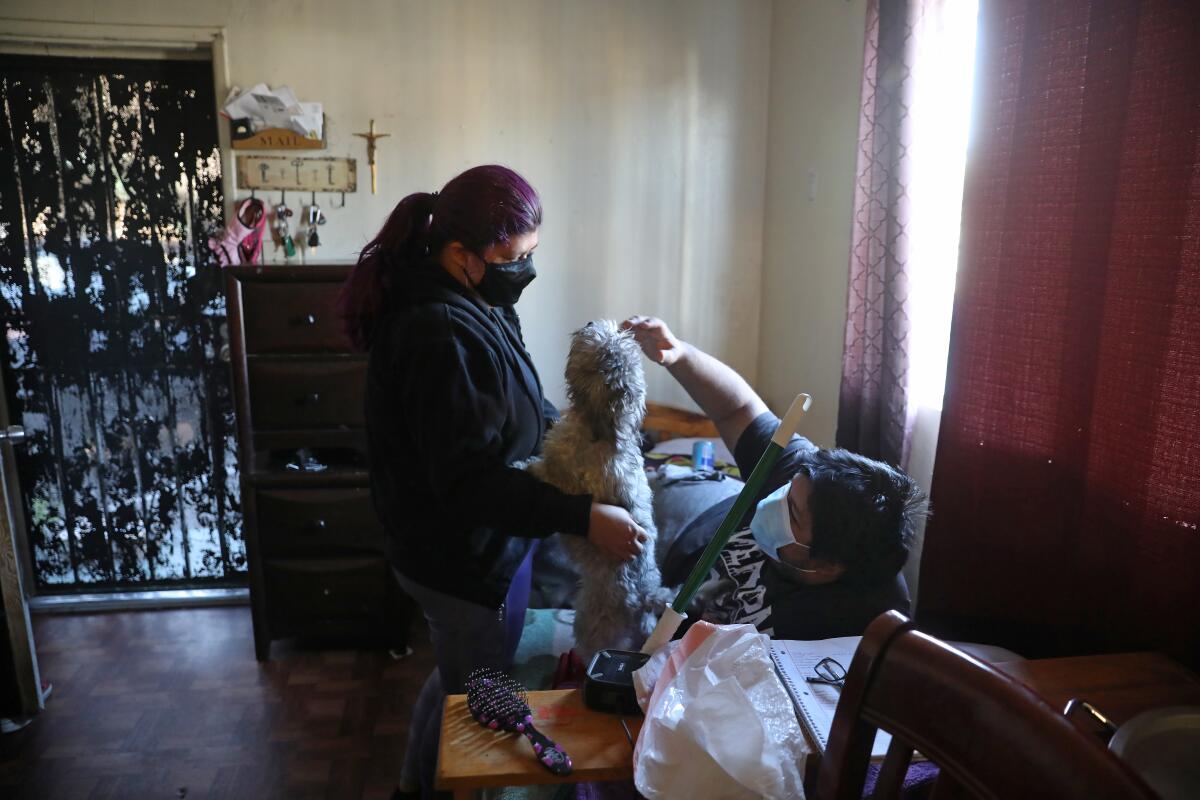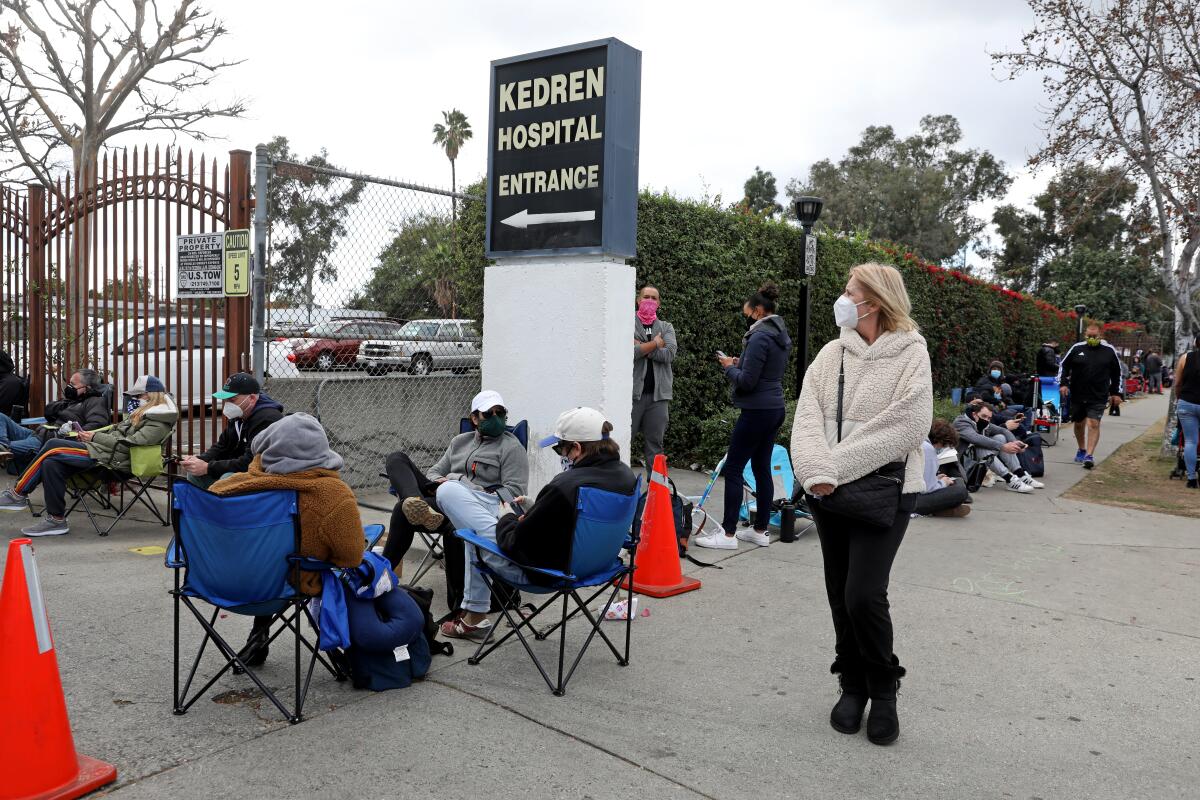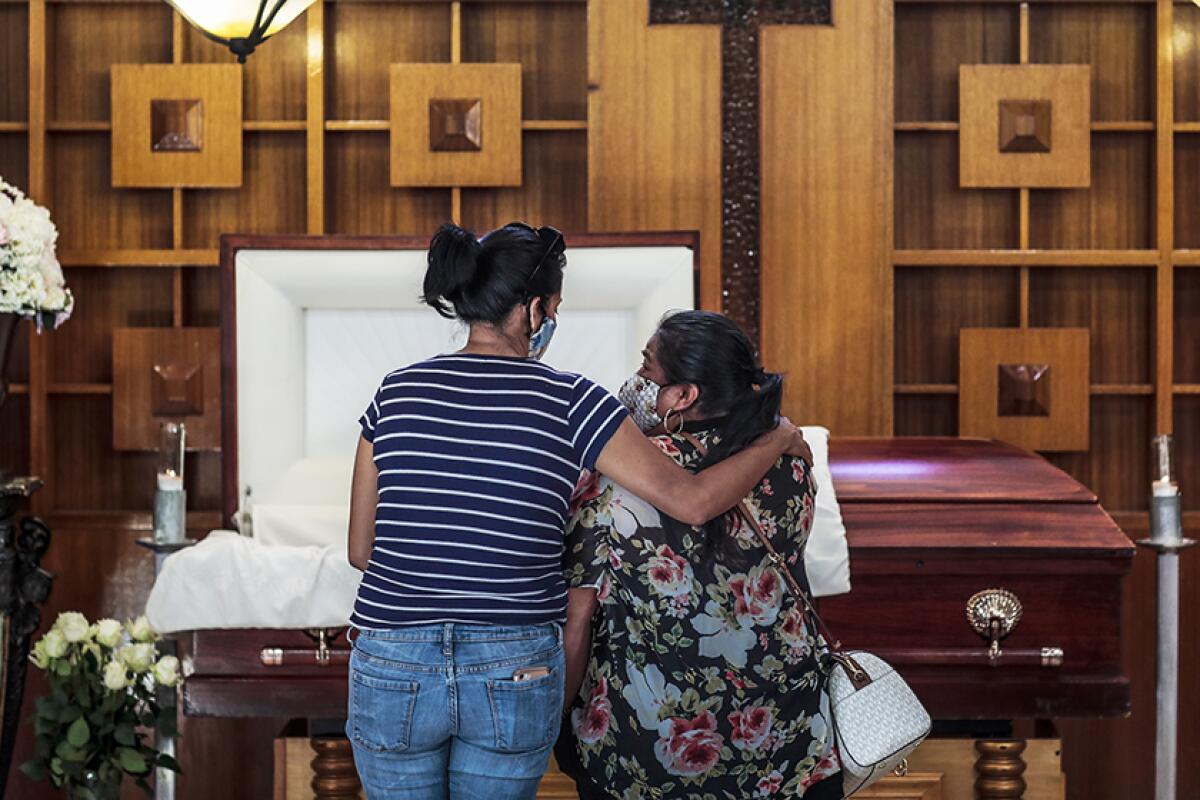Coronavirus Today: Shortages and second-shot anxiety
- Share via
Good evening. I’m Amina Khan, and it’s Friday, Jan. 29. Here’s the latest on what’s happening with the coronavirus, plus ways to spend your weekend and a look at some of the week’s best stories.
Authorities have been very clear about what needs to happen after Angelenos get their first dose of COVID-19 vaccine: Get the second shot three or four weeks later, depending on whether your vaccine was made by Pfizer and BioNTech or Moderna. It sounds simple, but for many folks in Los Angeles County, actually securing that appointment has been anything but.
Tightening vaccine supplies and online scheduling problems are hampering residents’ attempts to get their second doses. That’s a problem, because finishing their vaccinations on time is essential to get the fullest possible protection.
The second-dose appointment situation is also having unpleasant consequences for some folks in line for their first dose: On Thursday, potentially thousands of people had their vaccine appointments at Ralphs unilaterally postponed after the supermarket chain said 10,000 doses earmarked for its customers had been “recovered” by the county’s Public Health Department at the state’s request. A Ralphs spokesperson said only first-dose customers were affected, but it only added to the confusion.
Other residents are wasting hours navigating a frustrating and confusing online scheduling system. So many folks are worried about second doses that the county’s call center is jammed with as many as 1,000 calls an hour, public officials say. All this uncertainty underscores ongoing problems with the county’s management of diminishing vaccine supplies and the way it’s sharing critical information with a community desperate for answers, my colleagues Colleen Shalby, Jaclyn Cosgrove and Hayley Smith report.
Take Marjorie Klein, 76, who received her first dose of the Moderna vaccine at Dodger Stadium last week. When she was done, she obtained a card telling her to schedule an appointment for her second dose about 28 days later. But she has spent hours trying to sign up for that time slot in vain and has received no updates about when an appointment may open up. “The first shot means nothing unless you can get the second one,” said Klein, who compared the scheduling process to a scavenger hunt.
Experts agree the process leaves much to be desired. “There hasn’t been a lot of transparency,” said Andrew Noymer, a UC Irvine associate professor of public health. “Why can’t seniors get a straight answer when they ask?”
For what it’s worth, the Centers for Disease Control and Prevention last week updated its second-dose guidance to say that while people should receive their second dose as close to the target time as possible — three weeks after the first shot of the Pfizer-BioNTech vaccine and four weeks after the Moderna dose — they will still see efficacy if they wait up to six weeks.
Noymer said it’s understandable that people are confused, as information about second-dose logistics remains sparse and officials warn of limited vaccine supply. And while it’s likely that no one will miss the window for their second-dose shots, nothing seems to be set in stone.
“The first dose ought to be a promissory note on the second dose,” Noymer said. “When you get your vaccine card telling you that you received your first dose, you should receive a Post-it note stuck to that vaccine card that says where and when, down to the hour, the second dose should be administered.”
By the numbers
California cases and deaths as of 6:11 p.m. PST Friday:

Track the latest numbers and how they break down in California with our graphics.
See the current status of California’s reopening, county by county, with our tracker.


What to read this weekend
A desperate fight to protect their dad
Jose Guadalupe Zubia, a 59-year-old mechanic in South Los Angeles, was sharing a one-bedroom apartment with his four adult children when the coronavirus hit the family in October. Both sons and both daughters tested positive for the virus, and they desperately tried to protect their diabetic father — even as their own symptoms worsened.
The father and sons — Favian, 28, and Jonathan, 26 — all slept in surgical masks in the living room; Jose also cracked the window by his bed. The two daughters — Joanna, 29, and Priscilla, 20 — shut themselves in the single bedroom and wiped down everything in the apartment’s only bathroom with Lysol each time they used it.
“It’s easily spread as it is. When you’re living in such a small spot, it’s even harder to keep yourself away from somebody,” Joanna said. “What could we do?”
Like many Latino families in L.A., the Zubias live in overcrowded housing. Nearly all of their combined income went toward the rent of just over $1,000 a month. But in a county where the median home price is above $700,000, none could afford to move out. If you read one feature this week, let it be this one. It drives all the way home how, as Dr. Thanh Neville says in the story, “social distancing and working from home are privileges not everyone has.”

The underground COVID-19 economy
It’s no secret that the COVID-19 shutdown orders dealt a crushing blow to large swaths of California’s economy. But some business owners muddled through by operating under the radar. In L.A. and other counties with forced closures, you could still get your nails done, attend a Pilates session inside a studio and eat a restaurant meal with friends without resorting to takeout.
By continuing to serve customers, these businesses violated the spirit — and sometimes the letter — of the public health orders and undermined our collective efforts to contain the virus’ spread, my colleague Andrea Chang writes. For their part, the business owners say they weren’t trying to reject the government’s authority or protest rules on masks and social distancing. They were simply trying to make ends meet.
“I have a son to feed and to support, and rent to pay, and it was just getting too hard to not work at all,” said hairstylist Joanna Ho. “Even when the government was giving us stimulus and unemployment, it wasn’t enough.” Read more about how people like Ho powered this underground economy while dodging citations and threats to have their utilities shut off.
A stab — or a jab — for equity
Sara and Juan Saravia have three pandemic strikes against them: They’re elderly, they’re Latino and they live with a daughter who works as a housekeeper in a hospital with some of the region’s sickest patients.
But that last liability became an advantage recently: Because of their daughter’s job at Keck Hospital of USC, Sara, 81, and Juan, 83, were invited to get their COVID-19 vaccines. “Now I don’t have to worry as much,” said Sara, who proudly wore a red sticker that read, “I got my shot!”
The effort to vaccinate about 300 elderly relatives of hospital housekeepers, cafeteria and warehouse workers was part of a stab at equity, my colleague Brittny Mejia writes. Before the Saravias got their shots over the weekend, the overall vaccination rate among Keck staff was about 65% — but the rate among housekeepers was only about 40%. And that was an improvement from about two weeks prior, when just a quarter of the hospital’s housekeepers had gotten shots. The vaccination rate was similarly low among other divisions of the hospital staff that are predominantly Latino and Black.
“This is not dissimilar to what we’re seeing throughout the country — that Latinx and people-of-color communities are getting vaccinated at much lower rates,” said Keck Medicine of USC’s Felipe Osorno. That’s a problem, as L.A. County’s Latino and Black communities have borne the brunt of illness and death from the pandemic. “It was a tough pill to swallow,” Osorno said, “when the folks who are getting COVID the most, dying the most, are also the ones not accessing the vaccine.”
Finding vaccine equity solutions
Dr. Jerry P. Abraham, director of the always-overwhelmed COVID-19 vaccination site at Kedren Community Health Center in South L.A., is pioneering ways to combat the inequities plaguing California’s vaccine distribution.
The problem is made manifest in the two lines outside the facility. One features dozens of young, mostly white folks in yoga pants and beanies, sometimes lounging on beach chairs and blankets and with MacBooks on laps. Nearby is a long line of anxious older people, mostly Latino or Black and from the surrounding neighborhoods, many leaning on rickety walkers and canes.
People in the first line are hoping to snag leftover doses of the Moderna vaccine. Those in the second are the walk-up and appointment-holding Angelenos who are actually eligible.
Abraham’s goal is to make sure every vaccine he has goes into the arms of people in the second group — those who are most vulnerable to COVID-19. To that end, he’s found solutions to make it happen.
His is one of a handful of county-affiliated vaccination sites where people can arrive on foot instead of in a car. Interpreters for almost every language spoken in South L.A. are also on site. And rather than make elderly people wrestle with the clunky online portal, volunteers with paper forms are on hand to collect their information when they arrive and enter it into the county’s online databases later. Homeless people are also welcome.
“They deserve a vaccine just as much as everybody else,” Abraham said. “If they come here, they will leave with the vaccine in the arm. It creates a lot of headaches and challenges for us to report that information to the county and to the state and the federal government, but we will find a way.”

Student nurses step up to give shots
In the nadir of the pandemic’s “surge upon a surge,” with available intensive care unit beds at or near zero and nursing staff maxed out, several Southern California hospitals tapped into a ready-and-willing population of student nurses who could help give vaccines.
Take Naomi Muñiz, who had given a real shot only one time before she answered the call. Muñiz had just finished a stressful semester rotating in critical care at Long Beach Memorial Medical Center — but she returned on her first weekend of winter break, working back-to-back shifts vaccinating staff. “It wasn’t even a question of do I want to,” Muñiz said. “If they need help and I can help, I’m going to go in.”
The students’ call to duty comes just as the pandemic has made parts of their education difficult, my colleague Nina Agrawal writes, with teaching shifted online and many hospitals closing their doors to students in order to reduce exposure to the virus. By pulling them into the vaccination effort, “they get clinical experience,” said Dr. Rebekah Child, chair of Cal State Northridge’s nursing department. “It also fulfills their need in their heart of hearts, which is why most people get into nursing: to help people.”
Your support helps us deliver the news that matters most.
What to do this weekend
Get outside. Grab some snowshoes and head to Rim Nordic Ski Area in Running Springs, where you can take in the powder-coated peaks on groomed trails. (Check driving conditions with Caltrans before you go.) Or plan a trip to Channel Islands National Park, where you’ll find a new landing pier on Santa Cruz Island. Subscribe to The Wild for more on the outdoors.
Go for a drive. If you’re blessed with dinosaur-obsessed kids who can handle a car trip, consider taking them to Jurassic Quest at the Pasadena Rose Bowl this weekend. My colleague Jessica Gelt recently took her kids to the drive-through experience and reported having a memorable time. Subscribe to Escapes for more California travel ideas.
Watch something great. Our weekend culture watch list includes “Theatre Alive! A Virtual Celebration to Benefit School Theatre” — Tiny Fey, Samuel L. Jackson, Wayne Brady and Jennifer Hudson take part, among others. And in his Indie Focus newsletter’s roundup of new movies, Mark Olsen features “The Dig,” based on the true story of a vital archaeological find of medieval artifacts in rural England.
Eat something great. Cooking columnist Ben Mims scratches a citrus itch with Cambodian pomelo salad and gets his seafood fix with this tasty Laotian sheatfish curry. Subscribe to our Cooking newsletter for more mouthwatering inspiration.
Go online. Here’s The Times’ guide to the internet for when you’re looking for information on self-care, feel like learning something new or interesting, or want to expand your entertainment horizons.The pandemic in pictures

The COVID-19 death toll among L.A. County Latinos is reaching levels that the county’s top health officials have called “frankly horrifying.” When the latest surge began in November, Latino residents were dying from COVID-19 at an average rate of 3.5 per 100,000 each day. That number has skyrocketed to 40 deaths per 100,000 Latino residents — a more than 1,000% increase.
This photo, taken by Robert Gauthier, shows Iris Martinez standing with her friend Grace Salgado over the casket of Martinez’s father Rafael, who died of COVID-19. For me, it drives home what such horrifying numbers mean for the folks who are dying from it — or living with its tragic consequences.
Resources
Need a vaccine? Keep in mind that supplies are limited, and getting one can be a challenge. Sign up for email updates, check your eligibility and, if you’re eligible, make an appointment where you live: City of Los Angeles | Los Angeles County | Kern County | Orange County | Riverside County | San Bernardino County | San Diego County | San Luis Obispo County | Santa Barbara County | Ventura County
Practice social distancing using these tips, and wear a mask. Here’s how to do it right.
Watch for symptoms such as fever, cough, shortness of breath, chills, shaking with chills, muscle pain, headache, sore throat and loss of taste or smell. Here’s what to look for and when.
Need to get tested? Here’s where you can in L.A. County and around California.
Americans are hurting in many ways. We have advice for helping kids cope, resources for people experiencing domestic abuse and a newsletter to help you make ends meet.
For our most up-to-date coverage, visit our homepage and our Health section, get our breaking news alerts, and follow us on Twitter and Instagram.




